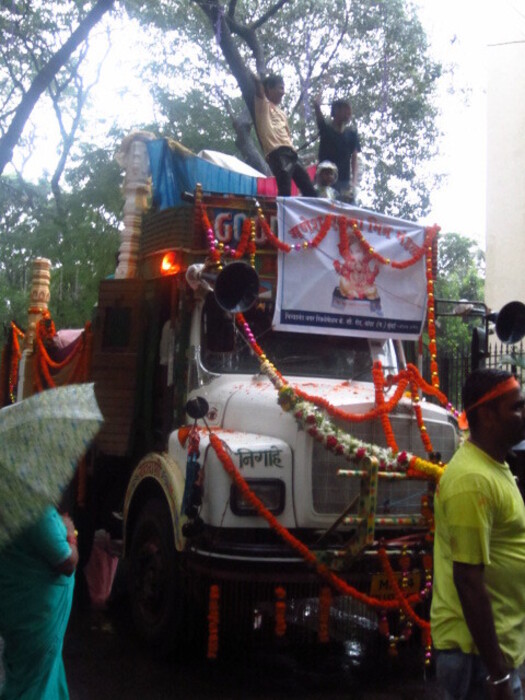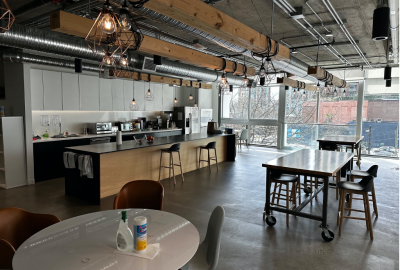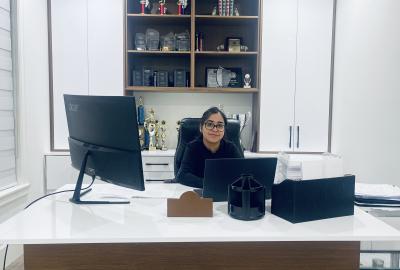
In the summer of 2011, four SFU Health Sciences Co-op students, Martyna, Silvia, Lindsay and Christine went on an INCREDIBLE 4-month work term to India. Working with Destiny Reflection, an organization whose goal is to empower female victims of human trafficking to become self-sufficient through dignified employment. Their blog series, SFU Health Sciences Takes India!, captures some of the experiences on their life changing journey.
Lindsay, Martyna, Silvia and I first landed in Mumbai at 3am on Sunday, September 11th. As we stepped off the air conditioned plane and walked through the ramp into the Mumbai airport, I felt the thick outdoor air oozing into the airport thought the seal between the plane and the ramp. It smelt somewhat sweet. I welcomed the warmth after freezing on the plane.
Even before we saw our names on the sign Minal was holding, she jumped up out of her seat and waved to us when we walked into the international arrival hall. Minal is a friend of Dr. Rochelle Tucker (my professor). Although we had never met her before, she has no problem identifying 4 Canadian students.
Minal organised 2 pre-paid cabs to take us to her friend Anu’s place where we were staying for 2 nights while in Mumbai. From the taxi I noticed that there was a lot of garbage that lined the streets. Along the road side, families lived in temporary shelters built from bamboo, and plastic tarps. Stray dogs and cats ran across the road. A truck honked loudly as it drove past us; the back sliding door was open exposing a group of young children. I wondered why a group of children were being transported in a pickup truck in the middle of the night.

In India people drive on the left side of the road. Out of habit I look right before crossing the street which is dangerous - nobody follows traffic rules. The painted lines on the road and traffic lights are irrelevant. Trucks, cars, rickshaws (aka autos), and motorcycles honk frequently to let each other know they are passing. In fact, drivers honk whenever they feel like it for no apparent reason. The vehicles weave in and out of traffic, and stick themselves into any space on the road that is available. Nobody wears seat belts and many taxis don’t even have seat belts. I think this is crazy especially since drivers often break very quickly. People cross the street everywhere expecting cars to stop for them. Many streets are lined with fences to prevent people from jay walking. The roads are absolute chaos, but to the people that live in India it is a part of life. I am learning to embrace it and walk across the road calmly like everyone else expecting cars to stop an inch away. Until then I will continue to run when I cross an intersection.
Sunday, September 11th was the last day of the Ganesh Chaturthi Festival in Mumbai. Strings of lights hung from the buildings. Although it was pouring rain, people decorated floats with statues of Ganesh and rode them down the street playing drum rhythms and dancing. The Hindu God Ganesh, is the remover of obstables. Ganesh is also considered the patron of “buddhi” - intelligence, wisdom, or intellect. The mouse is Ganesha’s vehicle, so the god is often depicted riding a mouse or with a mouse at its feet. The mouse can symbolize a pest that destroys crops, or in other words an obstacle that can be overcome.
We made two awesome friends in Mumbai. Both Anu and Minal were so kind. Minal welcomed us to India at the airport and Anu invited us to stay at her apartment. They both made the time to show us around Mumbai.
We went to a nice restaurant, did some shopping, saw a truck transporting chickens, and succeeded at getting a cab (where four of us could sit across the back bench)... to take us to see the Gateway of India.
The words engraved in the stone on the Gateway of India read “Erected to commemorate the landing in India of Their Imperial Majesties King George V and Queen Mary on the second of December MCMXI.”
At the Gate of India, a little girl of about 10 years old tried to sell me a string of white flowers. She insisted that they were good luck. I shook my head “no” and walked on. She followed and laid the white string of flowers over the wrist of my right hand where I held my video camera which made me stick out like a tourist if I did not already. She would not take it back from me, so I placed it over the rail of the fence that surrounded the Gateway of India. The security guards stared at us as we walked by. I said “Hello”. Anu later told me not to greet anyone, especially not security or police officers. She said I could not trust them. After I said “Hello”, Anu heard the security guard tell his companion in Hindi, “let’s check them.” We had already passed the check point so there was nothing he could do. Clearly I have some street smarts to learn.
Mumbai is a large metropolitan city on the west coast of India. There is a big difference between the living standards and the resources available to the rich and the poor. As we drove by large slums we noticed that some shelters had installed satellites. So some people are making enough money to eat, watch satellite TV and own a cell phone, but not enough money to buy land. As the plane took off from Mumbai on our way to Kolkata, outside the window we saw the vastness of the slums adjacent to towering buildings of the city. In Martyna’s words “it was mind blowing.”
Beyond the Blog
-
Learn more about Destiny Reflections
-
Follow Silvia, Christine, Martyna and Lindsay's Co-op journey in India through their blog series: SFU Health Sciences Takes India!
-
Find out more about the opportunities available through International Co-op
















